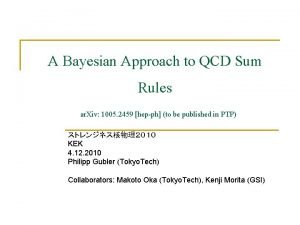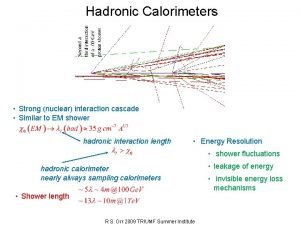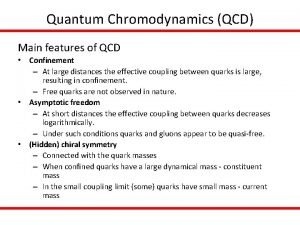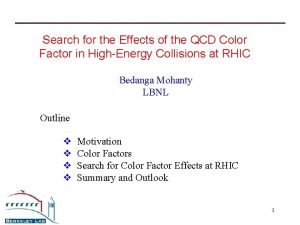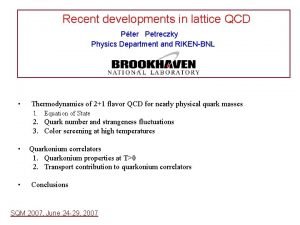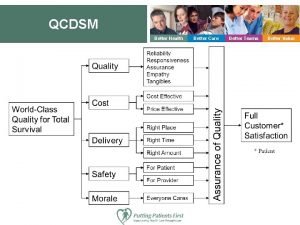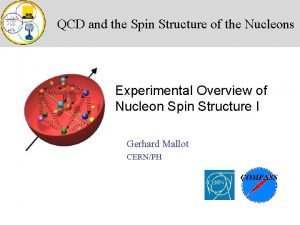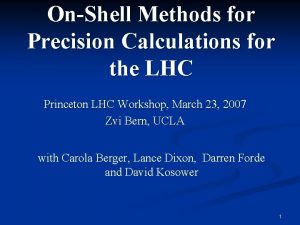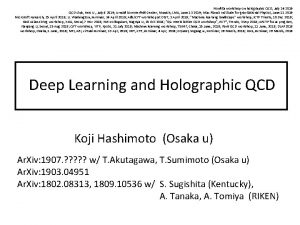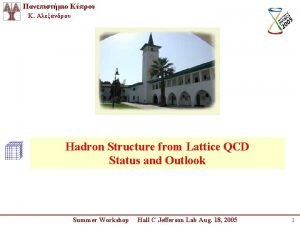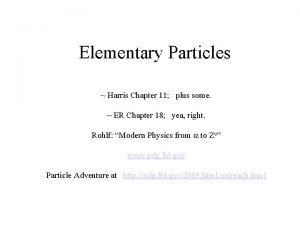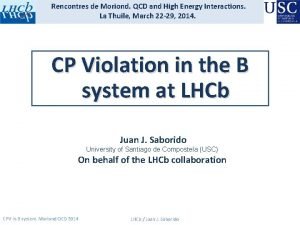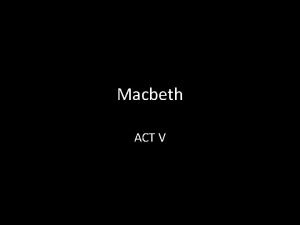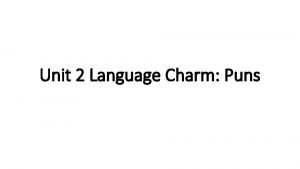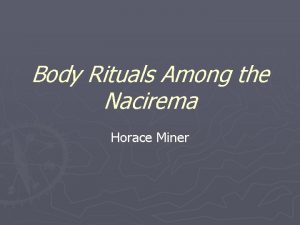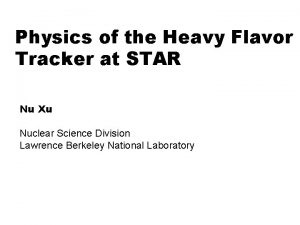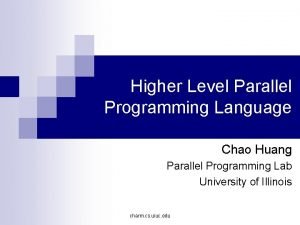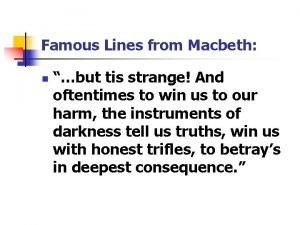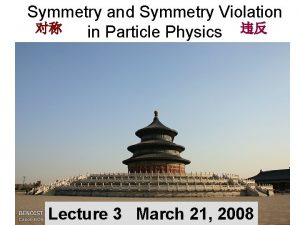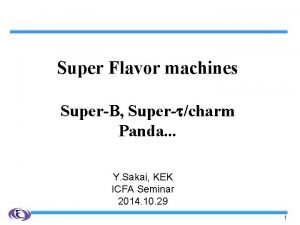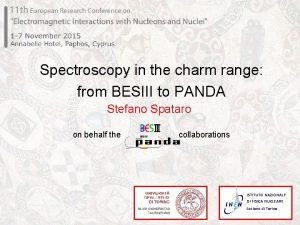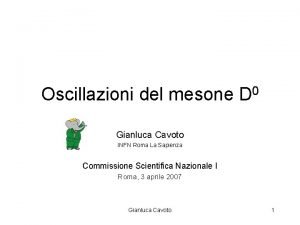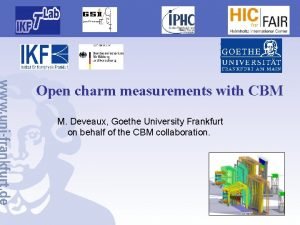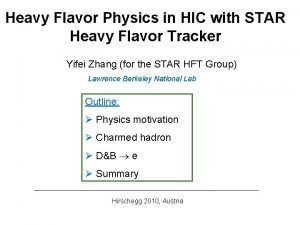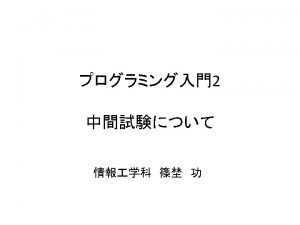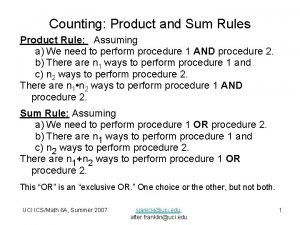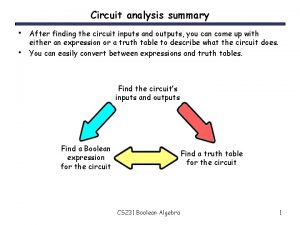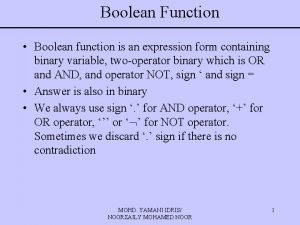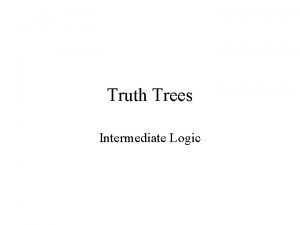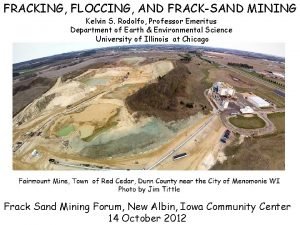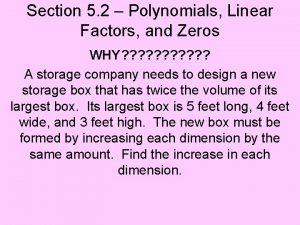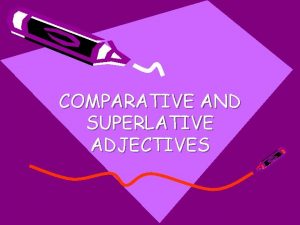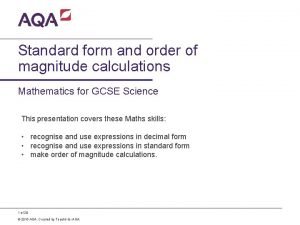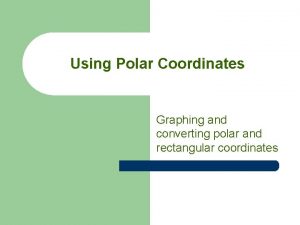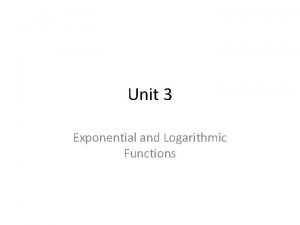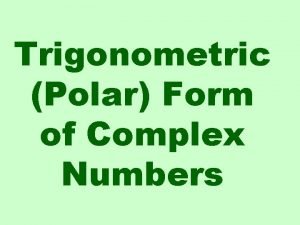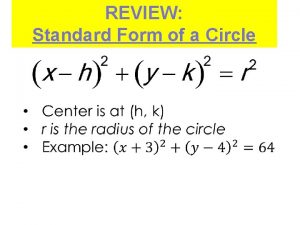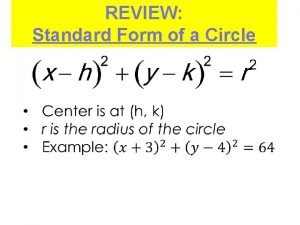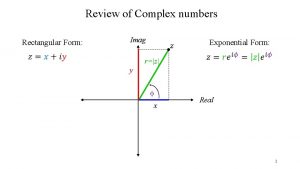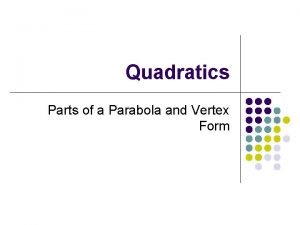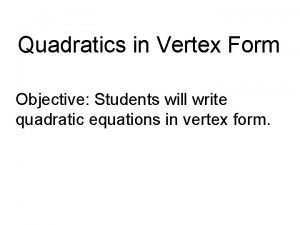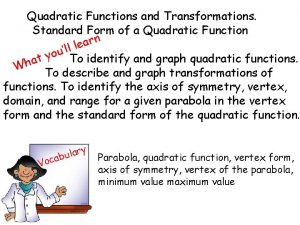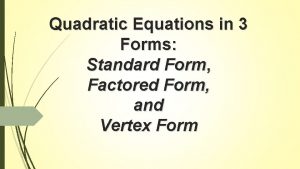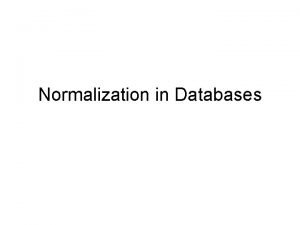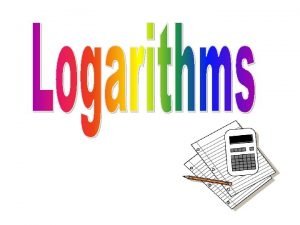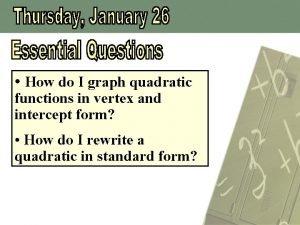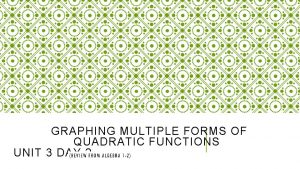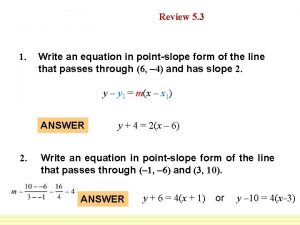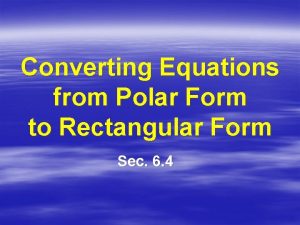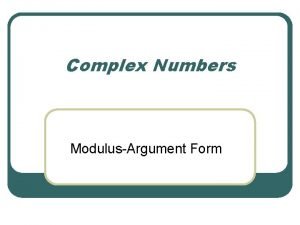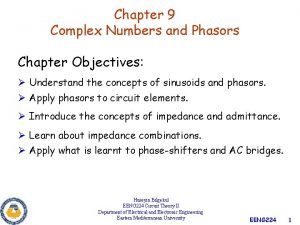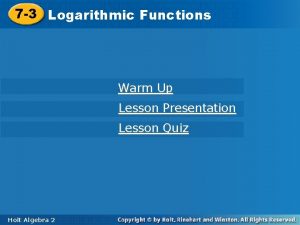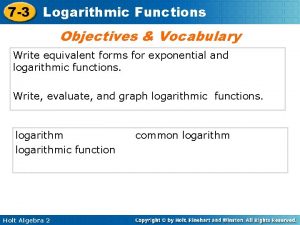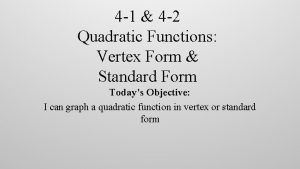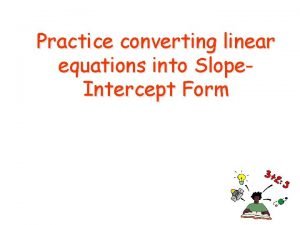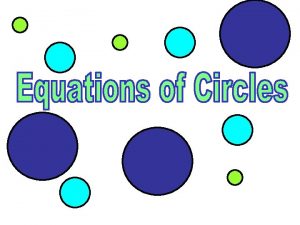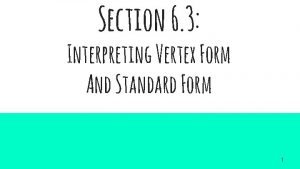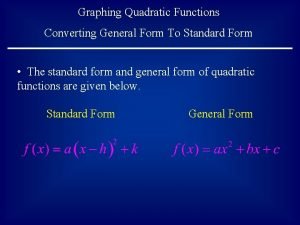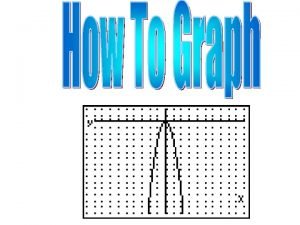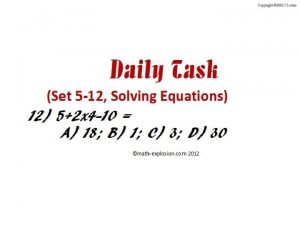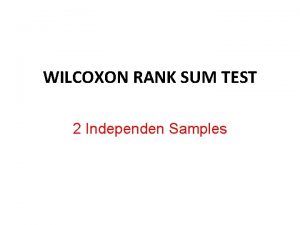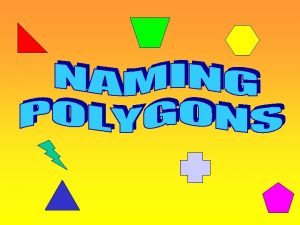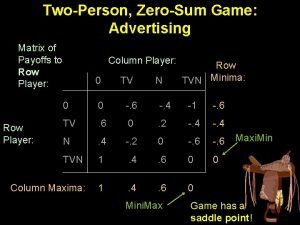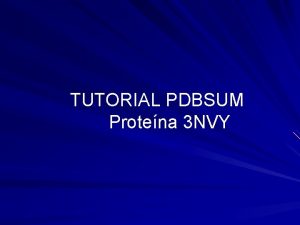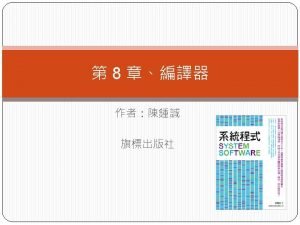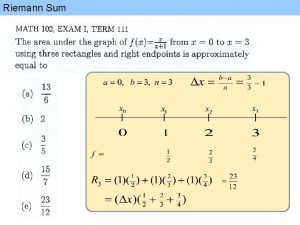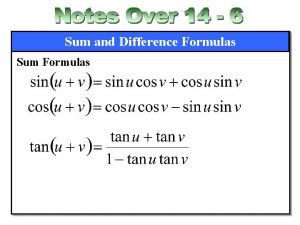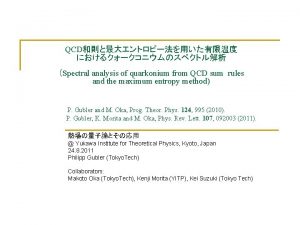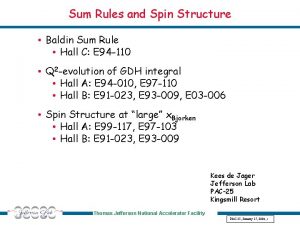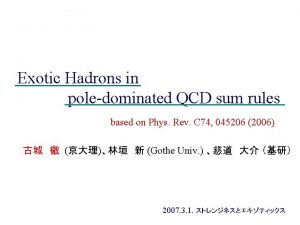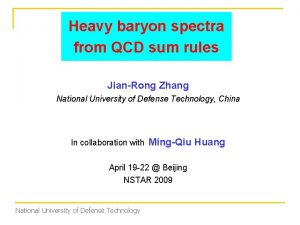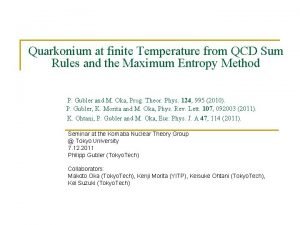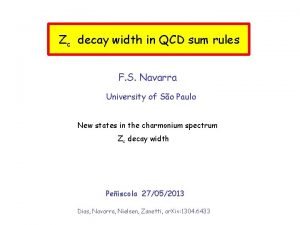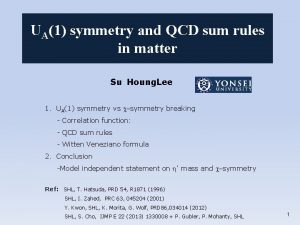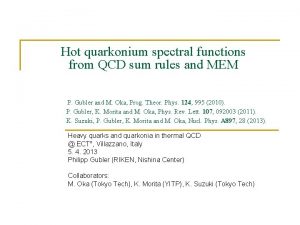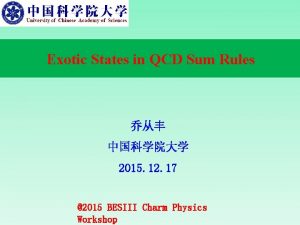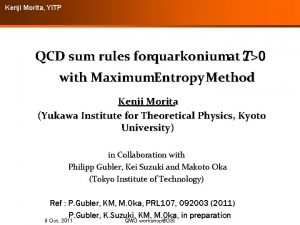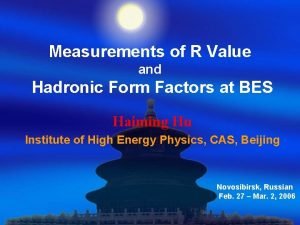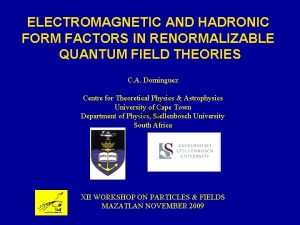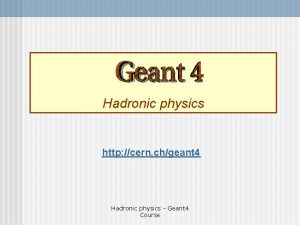Charm hadronic form factors with QCD sum rules



![interactions at FAIR Haidenbauer, Krein, Meissner, Sibirtsev ar. Xiv: 0704. 3668 [nucl-th] interactions at FAIR Haidenbauer, Krein, Meissner, Sibirtsev ar. Xiv: 0704. 3668 [nucl-th]](https://slidetodoc.com/presentation_image_h/13e54f7f317b9a6d10a80e3bd8602c73/image-4.jpg)



























































































- Slides: 95

Charm hadronic form factors with QCD sum rules Motivation QCDSR Results on form factors Application: charmonium production Conclusion F. S. N. , M. Nielsen IFUSP (São Paulo) BRAZIL

interactions at RHIC and LHC Charm form factors Lin, Ko nucl-th/0210014

Charmonium decays in B factories X (3872) Liu, Zhang, Zhu, hep-ph/0610278 X (3872)
![interactions at FAIR Haidenbauer Krein Meissner Sibirtsev ar Xiv 0704 3668 nuclth interactions at FAIR Haidenbauer, Krein, Meissner, Sibirtsev ar. Xiv: 0704. 3668 [nucl-th]](https://slidetodoc.com/presentation_image_h/13e54f7f317b9a6d10a80e3bd8602c73/image-4.jpg)
interactions at FAIR Haidenbauer, Krein, Meissner, Sibirtsev ar. Xiv: 0704. 3668 [nucl-th]

Form factors in QCD sum rules (data)

1) Write three-point correlation function: The QCD side (Operator Product Expansion side): 2) Choose the currents: 3) Insert the currents in and make the contractions:

4) Perform the OPE: The hadronic side (phenomenological side): 5) Insert hadronic states in + higher resonances

6) Use the matrix elements: 7) Use an effective Lagrangian to compute the amplitude: 8) Write

On both sides: 9) Decompose in tensor structures and choose one of them: 10) Write a double dispersion relation: 11) Identify 12) Apply a double Borel transform: double discontinuity

13) Write the sum rule: 14) Numerical analysis: Borel masses: Continuum thresholds : Numbers : or

15) Check Borel stability and OPE convergence: off-shell total perturbative gluon condensate

16) Fix M , plot fit and extrapolate to the meson pole: Exp. off-shell

Correlated extrapolation of the three form factors J/Psi D D*

Varying M and M´ independently: off-shell Good stability !

Dependence on the continuum threshold off-shell 0. 6 0. 5 0. 4

Couplings

Parametrizations:

Comments Coupling D*-D-pion compatible with data and with lattice QCD: data lattice Becirevic, Charles, Le Yaouanc, L. Olivier, Pene, Raynal, (2003) Compatibility with HQET relations : Oh, Lee, Song, PRC (2000) =

Application Charmonium production and absorption in nuclear matter Oh, Lee, Song, PRC (2000)

Application Charmonium production and absorption in nuclear matter “Charmonium regeneration”

without with

Conclusion Charm form factors are still very usefull for phenomenology Charm form factors change calculations by one order of magnitude We can calculate them with QCDSR (finished the first round) The obtained coupling constants are of the same order of magnitude The numbers roughly agree with previous phenomenological estimates The form factors were used in one phenomenological application

References M. E. Bracco et al. , Phys. Lett. B 521, 1 (2001) R. D. Matheus et al. , Phys. Lett. B 541, 265 (2002) F. S. Navarra et al. , Phys. Rev. D 65, 037502 (2002) M. E. Bracco et al. , Phys. Lett. B 605, 326 (2005) F. Carvalho et al. , Phys. Rev. C 72, 024902 (2005) R. D. Matheus et al. , Int. J. Mod. Phys. E 14, 555 (2005) M. E. Bracco et al. , Phys. Lett. B 659, 559 (2008) B. Osorio Rodrigues et al. , ar. Xiv: 1003. 2604 [hep-ph]

Three different particles off-shell in the vertex J/Psi D D*

Pole versus continuum off-shell

Errors Truncation of the OPE corrections Choice of tensor structure Pole + continuum Ansatz ~ 20 % Continuum threshold parameters Values of masses and condensates Choice of Borel mass Medium effects Extrapolation to the mass shell ?

Borel stability in different structures:

14 tensor structures Choose

Form factors in different structures :

versus

Couplings with vector mesons Matinyann, Muller, PRC (1998) Oh, Lee, Song, PRC (2000) not very compatible with VDM estimates :

P 1

P 3

P 3

P 4

P 4

P 4

P 5

P 5

P 5 Sergei G. Matinyann, Berndt Muller Phys. Rev. C 58: 2994 -2997, 1998. nucl-th/9806027

P 6

P 6

Kodjamirian


P 7

P 8

P 10


Frequent questions Higher dimension condensates ? Infinities ? Killed by Imaginary Corr + Cutkosky + Borel + s 0 / QHD Differences between on and off-shell ? Only Borel ? Compatible with SU(4) ? HQET ? VMD? Pole versus continuum (well defined ? ) changes with Q 2 ? Extension to quartic couplings ? Why the restrictions in the Q 2 region ? Why not smaller Q 2 ? Final errors ? Observable applications ?

Back ups

Borel stability: off-shell total perturbative quark condensate

Meson loops B) Meson loops with bare couplings

Introduce the : Calculate the loops and compute the vertex function Calculate the form factor of an off-shell D: fitted to adjust QCDSR points


16) Fix M , plot fit and extrapolate to the pion pole: Coupling constant: Exp. CLEO, PRL 87 (2001) How to reduce the uncertainties ?

Three different particles off-shell in the vertex ! sum rules off-shell

OPE convergence : total perturbative off-shell gluon condensate

J/Psi D


Parametrizations:


versus

versus

off-shell

Parametrizations:

Borel stability: off-shell

dependence on the continuum threshold parameters

Parametrizations: ( other structure )

structure Borel stability: off-shell perturbative total quark condensate

Dependence on the continuum threshold parameters

Form factors

Parametrizations:


Parametrizations:

Borel stability: off-shell total perturbative quark condensate off-shell perturbative

Dependence on the continuum threshold parameters:


Parametrizations:


List of form factors

The gluon condensate

The quark condensate

Oh, Song, Lee, Wong, nucl-th/0205065 Oh, Song, Lee, Wong, nucl-th/0010064 Liu, Ko nucl-th/070277 Phys. Rev. C 75, 064903 Charm form factors Oh, Song, Lee, Wong, nucl-th/0205065

Conclusion Motivação D* D pi : dados, rede, mais calculos feitos, mais leve! D* D Psi: mais pesado! D D Psi e D D rho: comparação de sondas diferente ! D* D* Psi e D* D* rho: comparação de sondas diferente ! D* D* pi D* D rho Table. . .

Motivation Understand J/psi and D interactions in hadronic and nuclear matter Understand final state interactions in B decays and X(3872) decays In the strange sector: . . . Form factors: simple parametrizations fitted to data Monopole: Coupling constant

Hyperon - nucleon interactions Haidenbauer, Meissner, Nogga, Polinder, nucl-th/0702015

12) Fix M , plot fit and extrapolate to the pion pole: PLB (2000) PRD (2002) Exp.



8) Check the pole dominance: old



É difícil acreditar. . .

But we can estimate the Laplacian : Compute the Lagrangian, energy-momentum tensor and obtain the EOS :

 Qcd sum rules
Qcd sum rules Hadronic
Hadronic Hadronic cascade
Hadronic cascade Qcd confinement
Qcd confinement Color factor qcd
Color factor qcd Qcd
Qcd Qcdst
Qcdst Qcd lagrangian
Qcd lagrangian Nucleon
Nucleon Qcd penrose
Qcd penrose Qcd
Qcd Qcd
Qcd Qed qcd qfd
Qed qcd qfd Rencontres de moriond
Rencontres de moriond Charm and grace
Charm and grace Let every soldier hew him down a bough
Let every soldier hew him down a bough Special charm and appeal 8
Special charm and appeal 8 Language
Language O the wonderful cross
O the wonderful cross Who are the holy mouth men
Who are the holy mouth men Tentaizu
Tentaizu Charm mesom
Charm mesom Charm programming language
Charm programming language Macbeth famous lines
Macbeth famous lines It has its charm
It has its charm Ffa charm
Ffa charm A charm quark has a charge of approximately
A charm quark has a charge of approximately Super wax charm
Super wax charm Charm
Charm Gianluca cavoto
Gianluca cavoto Charm
Charm Heavy flavor physics
Heavy flavor physics Supertunia mulberry charm
Supertunia mulberry charm Sum0
Sum0 Product sum rule
Product sum rule Present continuous interrogative form
Present continuous interrogative form Sum of minterm form
Sum of minterm form Canonical form boolean algebra
Canonical form boolean algebra Situation location
Situation location Is dirt abiotic or biotic
Is dirt abiotic or biotic Abiotic vs biotic factors
Abiotic vs biotic factors Abiotic factors and biotic factors
Abiotic factors and biotic factors Is a car abiotic or biotic
Is a car abiotic or biotic Location situation
Location situation All the factors of eight
All the factors of eight Common factors of 10 and 20
Common factors of 10 and 20 Gcf of 56
Gcf of 56 Short truth table method examples
Short truth table method examples Kelvin rodolfo
Kelvin rodolfo 84 as a product of prime factors in index form
84 as a product of prime factors in index form Preformulation definition in industrial pharmacy
Preformulation definition in industrial pharmacy Sff-ta-1008
Sff-ta-1008 5-2 polynomials linear factors and zeros form g
5-2 polynomials linear factors and zeros form g Rules comparatives and superlatives
Rules comparatives and superlatives Magnitude calculations
Magnitude calculations H and k in vertex form
H and k in vertex form How to add in polar form
How to add in polar form How to write a exponential function
How to write a exponential function Dividing polar form
Dividing polar form Circle standard form
Circle standard form General and standard form of a circle
General and standard form of a circle Complex exponential form
Complex exponential form How to find the value of a in vertex form
How to find the value of a in vertex form In vertex form
In vertex form Vertex to standard form
Vertex to standard form Quadratic factored form
Quadratic factored form Unnormalization
Unnormalization Long forms short forms
Long forms short forms Is y=x^2 exponential
Is y=x^2 exponential Maxwell equation for time varying field
Maxwell equation for time varying field Quadratic graph
Quadratic graph General form to vertex form
General form to vertex form Standard form can a be negative
Standard form can a be negative Polar form to rectangular form
Polar form to rectangular form Product of complex numbers
Product of complex numbers Exponential form to cartesian form
Exponential form to cartesian form 7-3 logarithms and logarithmic functions answers
7-3 logarithms and logarithmic functions answers Logarithmic to exponential form
Logarithmic to exponential form How to graph standard form
How to graph standard form Convert to trigonometric form 5i 3
Convert to trigonometric form 5i 3 Converting equations to slope intercept form
Converting equations to slope intercept form Equation of a circle general form to standard form
Equation of a circle general form to standard form Standard form of quadratic function
Standard form of quadratic function 19.3 interpreting vertex form and standard form
19.3 interpreting vertex form and standard form Converting general form to standard form quadratic
Converting general form to standard form quadratic What is the standard form for a quadratic equation
What is the standard form for a quadratic equation What is the slope of the function?
What is the slope of the function? Polar form to cartesian form
Polar form to cartesian form Cells form tissues. tissues form __________.
Cells form tissues. tissues form __________. Canonical form and standard form
Canonical form and standard form Trig form
Trig form Uji wilcoxon rank sum test
Uji wilcoxon rank sum test Polygon
Polygon 0 sum game
0 sum game Pbd sum
Pbd sum Triangle sum theorem
Triangle sum theorem
